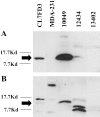Psoriasin (S100A7) expression and invasive breast cancer
- PMID: 10595935
- PMCID: PMC1866920
- DOI: 10.1016/S0002-9440(10)65524-1
Psoriasin (S100A7) expression and invasive breast cancer
Abstract
Alteration of psoriasin (S100A7) expression has previously been identified in association with the transition from preinvasive to invasive breast cancer. In this study we have examined persistence of psoriasin mRNA and protein expression in relation to prognostic factors in a cohort of 57 invasive breast tumors, comprising 34 invasive ductal carcinomas and 23 other invasive tumor types (lobular, mucinous, medullary, tubular). We first developed an IgY polyclonal chicken antibody and confirmed specificity for psoriasin by Western blot in transfected cells and tumors. The protein was localized by immunohistochemistry predominantly to epithelial cells, with both nuclear and cytoplasmic staining, as well as occasional stromal cells in psoriatic skin and breast tumors; however, in situ hybridization showed that psoriasin mRNA expression was restricted to epithelial cells. In breast tumors, higher levels of psoriasin measured by reverse transcriptase-polymerase chain reaction and Western blot (93% concordance) were significantly associated with estrogen and progesterone receptor-negative status (P < 0.0001, P = 0.0003), and with nodal metastasis in invasive ductal tumors (P = 0. 035), but not with tumor type or grade. Psoriasin expression also correlated with inflammatory infiltrates (all tumors excluding medullary, P = 0.0022). These results suggest that psoriasin may be a marker of aggressive behavior in invasive tumors and are consistent with a function as a chemotactic factor.
Figures




Similar articles
-
Psoriasin (S100A7) expression is associated with poor outcome in estrogen receptor-negative invasive breast cancer.Clin Cancer Res. 2003 Jul;9(7):2627-31. Clin Cancer Res. 2003. PMID: 12855640
-
Estrogen receptor-beta regulates psoriasin (S100A7) in human breast cancer.Breast Cancer Res Treat. 2007 Jul;104(1):75-85. doi: 10.1007/s10549-006-9390-x. Epub 2006 Sep 29. Breast Cancer Res Treat. 2007. PMID: 17009105
-
Psoriasin interacts with Jab1 and influences breast cancer progression.Cancer Res. 2003 Apr 15;63(8):1954-61. Cancer Res. 2003. PMID: 12702588
-
Psoriasin (S100A7).Int J Biochem Cell Biol. 1998 May;30(5):567-71. doi: 10.1016/s1357-2725(97)00066-6. Int J Biochem Cell Biol. 1998. PMID: 9693957 Review.
-
Opposing functions of psoriasin (S100A7) and koebnerisin (S100A15) in epithelial carcinogenesis.Curr Opin Pharmacol. 2013 Aug;13(4):588-94. doi: 10.1016/j.coph.2013.04.007. Epub 2013 May 9. Curr Opin Pharmacol. 2013. PMID: 23664757 Free PMC article. Review.
Cited by
-
Psoriasin (S100A7) expression is altered during skin tumorigenesis.BMC Dermatol. 2003 Feb 24;3:1. doi: 10.1186/1471-5945-3-1. Epub 2003 Feb 24. BMC Dermatol. 2003. PMID: 12600274 Free PMC article.
-
Structural characterization of S100A15 reveals a novel zinc coordination site among S100 proteins and altered surface chemistry with functional implications for receptor binding.BMC Struct Biol. 2012 Jul 2;12:16. doi: 10.1186/1472-6807-12-16. BMC Struct Biol. 2012. PMID: 22747601 Free PMC article.
-
RanBPM interacts with psoriasin in vitro and their expression correlates with specific clinical features in vivo in breast cancer.BMC Cancer. 2002 Nov 6;2:28. doi: 10.1186/1471-2407-2-28. BMC Cancer. 2002. PMID: 12421467 Free PMC article.
-
Relationship of coregulator and oestrogen receptor isoform expression to de novo tamoxifen resistance in human breast cancer.Br J Cancer. 2002 Dec 2;87(12):1411-6. doi: 10.1038/sj.bjc.6600654. Br J Cancer. 2002. PMID: 12454770 Free PMC article.
-
Differential expression of the protein kinase A subunits in normal adrenal glands and adrenocortical adenomas.Sci Rep. 2017 Mar 8;7(1):49. doi: 10.1038/s41598-017-00125-8. Sci Rep. 2017. PMID: 28250426 Free PMC article.
References
-
- Leygue E, Snell L, Hiller T, Dotzlaw H, Hole K, Murphy LC, Watson PH: Differential expression of psoriasin messenger RNA between in situ and invasive human breast carcinoma. Cancer Res 1996, 56:4606-4609 - PubMed
-
- Schafer BW, Heizmann CW: The S100 family of EF-hand calcium-binding proteins: functions and pathology. Trends Biochem Sci 1996, 21:134-140 - PubMed
-
- Lloyd BH, Platt-Higgins A, Rudland PS, Barraclough R: Human S100A4 (p9Ka) induces the metastatic phenotype upon benign tumour cells. Oncogene 1998, 17:465-473 - PubMed
-
- Sherbet GV, Lakshmi MS: S100A4 (MTS1) calcium binding protein in cancer growth, invasion and metastasis. Anticancer Res 1998, 18:2415-2421 - PubMed
Publication types
MeSH terms
Substances
LinkOut - more resources
Full Text Sources
Other Literature Sources
Medical
Molecular Biology Databases
Research Materials

